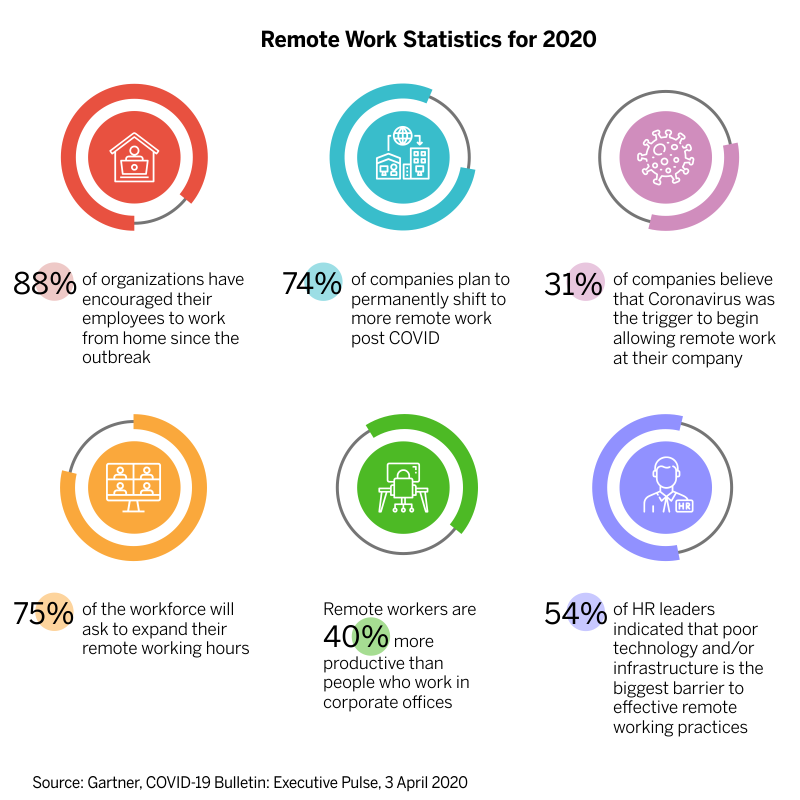Table of Contents
- Challenges of remote working during COVID-19
- Managing the transition to remote work
- Here are the 5 remote working tips for managers to keep employees productive
- Look at the silver lining
Step into a smarter digital workplace
Get a Free Product TourIn response to the uncertain situations presented by COVID-19, the organizations are moving to work-from-home practices. From the administrative staff to field workers, CEO to managers, everyone is working remotely, and everyone has a different way to deal with this new reality. So, we are in a situation of forced isolation and no one is aware of how long it will remain.
The world has been subjected to “social distancing”, “self-quarantine”, and “remote work”. And there are high possibilities that remote working practices are going to stay for a long time for a lot of people.
Challenges of remote working during COVID-19
Without direct contact, it becomes more difficult to build trust and establish a personal connection with employees. Also, there are fewer insights into the day-to-day tasks of the team and must experiment with different communication practices to help make their teams functional. Let’s understand these challenges better.
1. Lack of face-to-face supervision
When there is a lack of face-to-face interaction between managers and employees, most of the supervisors think that employees are not working efficiently. On the other hand, the employees struggle with the reduced access to managerial communication and support.
2. Lack of information access
Many times, remote workers need to put extra time and effort to locate information from colleagues. Getting answers to even simple questions can become a large obstacle for remote workers. These challenges extend beyond the task related to interpersonal issues. A lack of mutual knowledge among the team leads lowers the willingness to give the benefit of doubt to co-workers in difficult situations. For example, you will get a brusque email from your colleague if they are already having a rough day as a natural stress buster. And without any understanding of current circumstances, you are likely to get offended or think about the professionalism of your co-worker.
3. Social isolation
Remote work isolation and loneliness is a very common complaint when it comes to work from home practices. The employees miss so many social interactions that occur in office settings. If employees do not have the opportunity to connect with others, they suffer from isolation, lose the sense of belonging. As a result, it can impact employee retention rates.
4. Home distractions
When we search through some photos about “work from home” over the internet, it portrays casual images of people sitting at the sofa or doing multiple home chores along with official work. It is a terrible representation of remote working practices. A dedicated workspace and managed personal responsibilities are a must-have for effective virtual work. However, during this unplanned work-from-home transition, some distractions are expected. Still, you can make it better by distracting yourself from home and family demands for set working hours.
As a result of the COVID-19 pandemic, most of the organizations are dealing with these challenges and trying to explore tips for working remotely. Here are some stats that indicate the prevalence of remote working.

Managing the transition to remote work
On paper the situation is clear, but practicing is not that easy; the blurring lines of work and life are posing many challenges in our lives like:
- How to stay engaged at work?
- How to achieve better productivity?
- How to keep the discipline?
The answer to these questions is “A good manager”, but it is important to consider that team management is not a science.
Here are the 5 remote working tips for managers to keep employees productive.
1. Be planned for yourself and team
Many people have a habit of creating a to-do list every morning in the office. This practice is even more important while working from home. Make a set plan for your work and the work that needs to get done by your team. It creates an order that enables you to quick start your day. You can leave a time slab for ad-hoc tasks and unforeseen queries that come your way during the day such as contacting your colleagues and break time. Your planned time will help your colleagues to coordinate with you. Try to make this to-do list an everyday habit as it gives a structure to your work, help you align your goals, as well as proof of your daily achievements.
2. Clarify expectations and deadlines
The employees cannot succeed if they are not clear about your expectations, especially when your team is working remotely. You do not have a ready insight into what your employees are working on which can lead to distrust. Also, setting clear project and task deadlines always helps. Many people use the terminology “As soon as possible” which is not recommended because it does not define any deadline.
One of the most important remote working tips for employees is to be very clear about the tasks and their respective timelines. Don’t talk subjective when it is about expectations and deadlines.
3. Track project progress
Tracking project progress over mails can leave your employee inboxes to explode and, finding out mail trails is a big task itself. Instead, using a project management tool with a cloud-based approach can provide you greater flexibility of accessing the project information, team tasks, track progress, and a lot more.
Some of the inbuilt features of a project management tool are:
- Create and manage multiple projects with a single dashboard
- Quickly view the status of all projects and team assignments
- Search for projects by their name, by manager or lead, or by the time it spans
- Manage large projects by creating sub-projects under it
- Focused conversations with team members about a project, topic, or task to keep all project-related conversations in one place
- Get updates and feedback without creating email clutter
- Filter your tasks based on their status, due date, priority, and assignees
- Dedicated document libraries for each project where all documents can be stored, shared, and versioned
- Move and copy tasks between projects, create a list of action or backlog items, and export lists into an Excel spreadsheet
- Create custom lists to capture additional information such as budgeting, meeting notes and requirements.
4. Trust and Encourage Your Team
Remote working practices are new for many organizations and managers, but it does mean that managers should lose trust in the capabilities and professionalism of the team. Managers need to come out of the uncertainty zone that the task will get completed or not.
A great tip for working remotely is to set up work-from-home guidelines like:
- Emails that need to be responded within 24 hours
- Send a personal message in case of emergency
- No calls between certain hours and alike.
Moreover, it is also important to consider remote employees as valuable assets and not the alternate options. The virtual meetings and staff partnerships can help remote workers to feel valued in the organization.
Another important remote working tip for managers is to offer emotional support and encouragement to your employees. Managers need to listen to the challenges of employees and empathize with their concerns. Ask them questions like – “how are they doing?”, “how they are managing remote working situations?”. Sometimes, let the stress and concerns of employees be the focus of the conversation.
5. Different communication technology options
Email is not sufficient for all types of official communications. Remote workers deserve a richer technology like video conferencing as it gives visual cues that they would get during face-to-face interaction. A tremendous example of conferencing application is Microsoft Teams as it gives the visual cues to increase mutual knowledge and help reduce the sense of isolation while working from home. Another requirement is a mobile-enabled application that can help remote workers to collaborate easily and get time-sensitive information.
Look at the silver lining
The COVID-19 impact has forced all of us to work remotely and induced a lot of stress and anxiety. But at the same time, it is important to see the silver lining through these tips to work remotely and realize the benefits as you are learning many new things during this situation. Get a Free DEMO to learn more about how to adapt remote working culture in a better and collaborative manner.
Table of Contents
- Challenges of remote working during COVID-19
- Managing the transition to remote work
- Here are the 5 remote working tips for managers to keep employees productive
- Look at the silver lining
Step into a smarter digital workplace
Get a Free Product Tour

